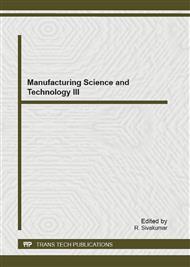p.767
p.771
p.777
p.781
p.787
p.791
p.796
p.801
p.806
Tribological Investigation of Nano Composite Coated Titanium Alloy Surfaces under Unidirectional Sliding
Abstract:
Industrial application of sliding components required to improve the tribological properties by increasing the surface hardness, friction and wear resistance. Modern modification of surface layers for friction applications combines surface texturing and filling of textured layers by wear resistant coatings of various compositions to improve its functional aspect and enhanced service life. Texturing of contact surfaces has a remarkable influence on their tribological properties, especially in the effect of wear and friction. This work proposes the coating of nano sized Titanium Aluminum Nitride (TiAlN) by Magnetron Sputtering-Physical Vapour Deposition (PVD) on the Titanium alloy (6Al-4V) substrate and study the performance of the coated surfaces by pin on disc tribometer. Two kinds of substrates were prepared one is the lapped surface and the other one is the textured surface by Laser beam machining. The Tribological performance of the wear resistant coatings on lapped and textured surfaces was experimentally investigated under various normal load conditions and the results were compared. Critical parameters such as friction coefficient, wear rate, wear volume, wear morphology and micro wear mechanism were investigated in this work. The coating surfaces and wear scars were evaluated by scanning electron microscopy (SEM) and energy dispersive X-ray spectroscopy (EDAX). The results showed that the TiAlN coating on textured surfaces exhibited lower friction coefficient and wear rate than the TiAlN coating on lapped surfaces under same testing conditions.
Info:
Periodical:
Pages:
787-790
Citation:
Online since:
December 2012
Authors:
Price:
Сopyright:
© 2013 Trans Tech Publications Ltd. All Rights Reserved
Share:
Citation:


